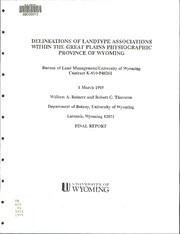
Delineations of landtype associations within the Great Plains physiographic province of Wyoming : final report PDF
Preview Delineations of landtype associations within the Great Plains physiographic province of Wyoming : final report
BLMLIBRARY 880500 DELINEATIONS OF LANDTYPEASSOCIATIONS WITHIN THE GREAT PLAINS PHYSIOGRAPHIC PROVINCE OFWYOMING BureauofLandManagement/UniversityofWyoming ContractK-910-P40261 1 March1995 WilliamA.Reiners andRobertC.Thurston DepartmentofBotany,UniversityofWyoming Laramie,Wyoming82071 FINALREPORT UNIVERSITYOF UJ WYOMING GB 428 .W8 R454 1995 1 zU *tf>6 i : 4>3 TABLEOFCONTENTS ,LOg 1.0 OBJECTIVESOFTHEWORK 1 49? 2.0 PHILOSOPHYOFTHEWORK 1 2. Conceptofthe"Ecosystem"in TermsofEcosystemManagement 1 2.2 ConceptoftheLandscape 3 2.3 ConceptofLandManagementAccordingtoSound EcologicalPrinciples 4 3.0RELATIONSHIPWITHECOMAP 6 4.0METHODS 9 4.1 DataUsedtoDelineateMapUnits 9 4.2 MapAccuracy 11 4.3 InteractionswithBLMPersonnel 13 5.0 LANDAREADELINEATIONS:RATIONALESANDDESCRIPTIONS 5.1 Overview 14 5.2 RationalesandDescriptionsofDomain, DivisionsandProvinces 17 5.3 SectionsandSubsectionsoftheGreatPlains- Palouse-DrySteppeProvince 18 5.3.1 NorthwesternGreatPlainsSection 20 5.3.1.1. UplandPlainsSubsection 20 q- 5.3.1.2. GoshenHoleSubsection 20 ^>.-gtoo.-oUsjJroQK:g£cujv5.3.2 P5o.3w.d2e.1rRUipvlearnBdasPilnainSsecStuibosnection '. 2211 <jCsDo<CDmqh,oOXqpon- 5.3.2.2 DissectedPlainsSubsection 21 z Q Qin 5.3.2.3 ScoriaHillsSubsection 22 5.4 LandtypeAssociationsoftheGreatPlains Province 23 5.4.1 RollingPlainsLandtypeAssociation 23 5.4.2 Dune-mantledPlainsLandtypeAssociation 24 5.4.3 ParallelCuestaandValleyLandtype Association 25 5.4.4 SingleCuestaLandtypeAssociation 26 5.4.5 RecessionalEscarpmentLandtype Association 27 5.4.6 DissectedAnticlineLandtypeAssociation 28 5.4.7 MajorRiverValleyLandtypeAssociation 28 5.4.8 DissectedPedimentLandtypeAssociation 29 5.5 SectionsandSubsectionsoftheBlackHills ConiferousForestProvince 30 5.4.1 DissectedPlateauSubsection 31 5.4.2 BearLodgeMountainsSubsection 32 5.4.3 Interior(Red)ValleySubsection 32 5.4.4 BlackHillsSubsection 33 5.5SectionsandSubsectionsoftheSouthernRocky MountainSteppe-OpenWoodlandConiferous Forest-AlpineMeadowProvince 33 5.6SectionsandSubsectionsoftheIntermountain Semi-DesertProvince 34 6.0CONTRACTPRODUCTS 34 7.0LITERATURECITED 35 8.0FIGURES 37 9.0APPENDIX 48 1.0OBJECTIVESOFTHEWORK 1.1RequirementsoftheWorkOrder 1.1.1 "TheUniversityofWyoming,DepartmentofBotany,willdelineatelandscape complexes(landtypeassociationssensuBailey(1980)withintheportionoftheGreat PlainsPhysiographicProvinceoccurringinWyominginthecountieslistedunder- locationofwork" 1.1.2 "ThelocationoftheworkareaisCrook,Weston,Niobrara,andConverse Counties,Wyoming" 1.1.3 "DelineationswillbebasedonacombinationofLANDSATThematicMapper remotelysensedimagery;GIS(geographicinformationsystem)spatialdatarepresenting topography,geology,climate,soilsandvegetativelandcover;andaidedbyextantmap delineationssuchasBailey'secoregions(Bailey1980)andHammond'sphysiographic landunits." 1.1.4 "ThelandscapecomplexeswillbeprovidedinbothpapermapformandArc/Info digitalform. Thescale,organizationandotherrelateditemswillbedeterminedbythe BLM." 1.1.5 Deliverables[willinclude]: a)25copiesofawrittenreportwithrationaleforthedelineations, b)apreliminarymapproductwithin5monthsoftheinitiationoftheagreement, c)3setsofslidesofthemaps, d)3setsofoverlaysfortheoverheadprojector, e)3largepapermapswillbeproduced. Scaleandcontenttobedeterminedby theBLM. Inourownwords,theobjectiveofthisworkistoprovideascientificallybased spatialframeworkforecosystemmanagementintheGreatPlainsPhysiographicProvince ofWyomingthatincorporatesecologicalprinciplesandprocessesacrossarangeof scales. 2.0PHILOSOPHYOFTHEWORK 2.1Conceptofthe"Ecosystem"inTermsofEcosystemManagement ThisworkisacontinuationofrelatedworkwiththeWyomingStateOfficeofthe BLMinwhichwedelimited"ecosystemboundaries"fortheBuffaloResourceArea (ReinersandThurston1994). Inthatreportwediscussedtheconceptofecosystem management—theinstigatingmandateforthiswork—illustratingtheimprecisionofthis conceptwithdifferingstatementsonwhatecosystemmanagementmeans. Toprovide 1 similarcontextforthispresentreport,itisworthexpandingonsomeofthebackground statementswewroteinthatproceedingreport. Traditionally,andeveninmostcontemporaryecologicalresearch,theecosystem conceptcarriesasenseofhomogeneity,andtherealworldisviewedasamosaicof local-areaecosystems. "Themostcommonuseofecosystembyecologistsisinalocalizedsense, referringtoadistinctandcoherentecologicalcommunityoforganismsand thephysicalenvironmentwithwhichtheyinteract"Slocombe(1993) However,appliedecologistsandlandmanagersrecognizethatthislocalsiteusageisnot necessarilytheonlyorbestusageinthecontextofecosystemmanagement. Recognizing thatbroaderlandunitssuchaslandscapesorregionscanbetreatedasecosystems, Slocombesuggeststhatabetterconceptofecosystemis "thenotionofabounded,self-maintainingsystemofvaried,livingand nonliving,interactingparts." Thisdefinitionishardlymorehelpfulbuttheintentistoacceptmoreinternal heterogeneityintheecosystemdefinitionandtomaintainthebasicideainteractions, includinginteractionsbetweendifferentlocal-areaecosystemsinalargerspatialcontext. Amongthemostsatisfactorystatementsonecosystemmanagementarethose basedonpersonalcommunicationwithProf.D.H.Knight. Knightliststheseworking rules: "-focusonlargerareas, -considerboundaryeffects, -considereffectsoflandscapechange, -realizethatchangesoccurregardlessofmanagement, -takealong-termperspective, -predictcumulativeeffects, -monitorkeyvariables, -manageforsustainability,and -practiceintegratedplanning." IfweadopttherulesKnight(andothers)suggest,then"managementunitecosystems" are,bydefinition,goingtobelargerthantheconventional,site-levelecosystem. Knight saysthatmanagementunitecosystemsinvolvelandscapes,whichinturn,representthe aggregationofrelatedterrainunits,eachbearingoneormorekindsofsite-level ecosystemsonthem. Thismakessensetousandweconcludethatlandmanagement ecosystemswillberelativelylarge,incorporatingatleastonelandscape,tobedefined anddiscussedbelow. 2.2 ConceptoftheLandscape Like"ecosystem,""landscape"isanabstraction-ahumanconstruct-andhasno absolutedefinitionthatautomaticallyimposesboundariesonrealterrain. Like ecosystems,landscapescanbestudiedatdifferentspatialandtemporalscales. Forman andGodron(1986)definelandscapeas: "aheterogeneouslandareacomposedofaclusterofinteracting componentsthatisrepeatedinasimilarformatthroughout." Wesuggestthatthisdefinitionisweakenedbytheuseoftheterm"cluster"which impliesathree-dimensionalaggregation(e.g."clusterofgrapes"). Withsubstitutionof theterm"mosaic,"foratwo-dimensionalarray,for"cluster,"thisdefinitionisa reasonable,ifabstract,definitionoflandscape. Elaboratingonthese"components"FormanandGodron(1986)discusscharacteristics typicallyrepeatingacrosslandareas: "1)aclusterofecosystemtypes,2)theflowsorinteractionsamongthe ecosystemsofsuchacluster,3)thegeomorphologyandclimate,4)theset ofdisturbanceregimes,and5)therelativeabundanceofecosystemsin suchacluster."(fromRisser1987) Wedrawparticularattentiontoitemthreeinthatseries-geomorphologyandclimate. Wewillarguelaterthattheprincipaldeterminantwehavetouseinordertodefinea landscapeintangibleterms,thatis,asmappedlandunitsontheground,willbe topography,determined,atthisscale,mainlybygeomorphologicalpropertiesofthe terrain. Climateisoneofthedeterminantsofgeomorphologybutmacroclimate,at least,ismoregenerallyexpressedoveralargerareaandthusisnotusuallyuniquetoa particularlandscape. TurnerandGardner(1991)havedefined"landscape"slightlydifferently: "Landscapecommonlyreferstothelandformsofaregioninthe aggregate...ortothelandsurfaceanditsassociatedhabitatsatscalesof hectarestomanysquarekilometers. Mostsimply,alandscapecanbe consideredtobeaspatiallyheterogeneousarea." Theseauthorsdiscussecologyinthelandscapecontext("landscapeecology")anddefine variousdimensionsofthatsubject. Ofinteresttothisreportisabrieflistingof landscapepropertiesbythoseauthors. "Threelandscapecharacteristicsthatareespeciallyusefultoconsiderare structure,functionandchange... Structurereferstothespatial relationshipsbetweendistinctiveecosystems,thatis,thedistributionof energy,materialsandspeciesinrelationtothesizes,shapes,numbers, kinds,andconfigurationsofcomponents. Functionreferstothe interactionsbetweenthespatialelements,thatis,theflowofenergy, materials,andorganismsamongthecomponentecosystems. Changerefers toalterationinthestructureandfunctionoftheecologicalmosaicthrough time." Structure,functionandchangeparallelpropertieslistedbyFormanandGodron(1986) butarestillrelativelyabstractterms.Whatdotheymeantolandmanagers? Meaning hastobegivento"structure,""function"and"change"bymanagerswhoarechargedwith evaluatingandprescribingpracticesforarealpieceofterrain. Morerecently,anFederalinteragencycommitteepertinenttothisworkorder (ECOMAP)hasdefinedlandscapeas: "aheterogeneouslandareacomposedofaclusterofinteractingecosystems thatisrepeatedinasimilarformthroughout;andcanbeviewedatone timefromoneplace(adaptedfromFormanandGodron,andWebster)." (ECOMAP1993) ThisdefinitionisessentiallythesameasthatquotedabovefromFormanandGodron, exceptfortheprovisothatalandscapecanbeviewedatonetimefromoneplace. This isacuriousclauseinthattheviewingrangedependsonthepositionoftheviewerwhich couldextendfromthebottomofagullytoasatelliteplatform. Inouropinion,this definitionhastheweaknessoftheoriginalFormanandGodrondefinitionandis compromisedstillfurtherbytheambiguityofviewingposition. 2.3 ConceptofLandManagementAccordingtoSoundEcologicalPrinciples Whatistherelationshipbetween"ecosystem,""ecosystemmanagement,"and "landscape?" Wesuggestthatthelandscapeconcept,thoughabstract,maybeacritical interfacebetween"ecosystem"and"management." Wesuggestthattheconceptof"landscape"carrieswithitconnotationsmeantby "ecosystemmanagement." Landscapes,bydefinition,consistofheterogeneousterrain andincorporatethenotionofspatialinteractions,andcomplexchangeoverspacewith time-vitalconsiderationsfor"ecosystemmanagement." Ononehand,thelandscapecan takeonthedefinitionofaspecialkindofecosystem,ontheotherhand,werecognize thatalandscapecanbedecomposedintoamosaicofwhatarenormallyconsidered morehomogeneous"ecosystems." Whiletheconceptofalandscape-ecosystemseemsentirelycongruentwith conceptsofecosystemmanagement,theproblemofdefiningactuallandscapesonreal terrainstillremains. Wesuggestthattherearetwo,complementaryresolutionstothis problem. Thefirstresolutionisacceptanceattheoutsetthatlandscape-ecosystemscan rangeinscalefromhectarestomanysquarekilometers. Differentscalesareappropriate fordifferentissues. ECOMAP(1993)explicitlyrecognizesthisinadoptingahierarchical frameworkfordifferentlevelsofplanningandanalysis. Corollarytothisviewisthefact thatsmallerlandscapescanbenestedwithinlargerones. Stilltobedeterminedisa practicalscale,ornestinglevel,foraparticularenvironment. Surely,practical operationalscaleswouldbelessinfine-grained,highreliefterraincharacteristicofwell- dissectedmountains,thaninbroadlysweepingplains. Thesecondresolutionofthisproblemisrecognitionthatlandscape-ecosystems canandmustbedefinedintermsofthephenomenon,criterion,ormanagementissueat hand. Iftheissueiswaterquality,thenwatershedboundariesmakefinelandscape delineations. Iftheissueiswildlifehabitat,thenotherterrainconfigurationsrelevantto theforage,waterandcoverrequirementsofwildlifebecomefundamentaltolandscape definition. Inotherwords,.definitionoflandscape-ecosystemsisatsomeoperational levelsituational. Fromthis,itfollowsthatlandscape-ecosystemscannotbedefineda prioriforallcircumstances. However,itisreasonablethatterrainunitshavingsimilar environmentalfeaturescanrepresentunitshavingsimilarkindsoflandscape-ecosystems definableonasituationalbasis. Thegoalofthisworkistomapterrainfeatureshavingsimilarterrain configuration,ecologicalpropertiesandmanagementimplicationswithinwhich situationallandscape-ecosystemscanlogicallyandconvenientlybedefined. Withinthe formalstructureoftheECOMAP(1993)nationalhierarchyofecologicalunits,wehave mappedLandtypeAssociations. LandtypeAssociationsaredefinedbyECOMAP(1993) asunitsatthe"landscapescale"asfollows: "groupingsofLandtypesorsubdivisionsofSubsectionsbasedupon similaritiesingeomorphicprocess,geologicalrocktypes,soilcomplexes, streamtypes,lakes,wetlands,andseries,subseries,orplantassociation vegetationcommunities. Repeatablepatternsofsoilcomplexesandplant communitiesareusefulindelineatingmapunitsatthislevel. Namesof LandtypeAssociationsareoftenderivedfromgeomorphichistoryand vegetationcommunity." Forourpurposesinthismappingwork,weviewLandtypeAssociationsasaggregatesof similarlandscapes,regardlessofwhatevercriterionisusedforlandscapedefinition. LandtypeAssociationsarerelativelylargeunits(100'sto1000'sofacres)featuring predictablyoccurringterrainfeatures. Diagnosticterrainfeaturescharacteristicof LandtypeAssociationsincludetheform,extentandnatureofridges,cliffs,rock outcrops,talusslopes,fans,streamchannelsandassociatedterraces,benches,ravines, etc. Weexpectthateachoftheseterrainfeaturesmaybeardifferentecosystem componentsintermsofplant,animalandmicrobialpopulationsandfunctions,andcan beviewedaslocalareaecosystems. Webelievethatunderstandingthetopographicandecologicalcharacterof individualLandtypeAssociationswillbeaninitialsteptoeffectivesubdivisionofthese intolandscapesdeterminedbydefinedmanagementneeds. Forexample,further subdivisionmightwellbedoneattheleveloffirstorsecondorderwatershedsinsome cases,orencompassanentireridge-escarpmentunitinothers. Howeverdefined,itis importantthattheselandscapeunitswillhaverecognizablestructural,functionaland temporallydynamicpropertiesasoutlinedbyTurnerandGardner(1991). IndecidingwhethergeographicfeaturesshouldbemappedasaLandtype Association,wehaveaskedourselvesthepracticalquestion: "wouldthisfeatureberecognizedbylandusersandmanagersinthefield, andwouldtheyagreethatitissufficientlydifferentfromsurrounding terrainthattheywouldconsideritsmanagementdifferently?" InmappingLandtypeAssociations,wehavenotmappedlandunitsonthebasisofwhere boundariesoughttobebasedonsmallscale(lowresolution)climateorgeologymaps, butrather,whereGISdataandourfieldreconnaissanceindicaterecognizablecommon terrainpropertieswithintheAssociationthatarerecognizablydifferentfromterrain outsideoftheAssociation. InadditiontomappingLandtypeAssociations,wehavealsomappedhigher hierarchicallevelsoftheNationalHierarchyofEcologicalUnitsforthedefinedmap area(seesectionbelow). Inthisprocess,wehavedefinedlandunitsuptotwo hierarchicallevelsaboveLandtypeAssociation. Thesedefinitionsofhigherhierarchical unitsconformwithnationallyacceptednomenclaturebutdiffer,insomecases,with respecttolocation. 3.0RELATIONSHIPWITHECOMAP InthetimesincethiscontractwasmadebetweenBLMandtheUniversityof Wyoming,amemorandumofagreementbetweentheUSDAForestService,DOI BureauofLandManagement,NationalBiologicalSurvey(Service),U.S.Geological Survey,FishandWildlifeService,andtheEnvironmentalProtectionAgencyhasbeen signedforthepurposeofdevelopingacommonecologicalmapoftheUnitedStates. ThestructureforthismappingprojectisdefinedasaNationalHierarchicalFramework ofEcologicalUnitsandhasbeendefinedanddiscussedinareportwiththesametitle andcitedhereasECOMAP(1993). ThisnationalhierarchicalframeworkdiffersfromthepreviousHierarchical system(Bailey1980)usedinourreportonourworkwiththeBuffaloResourceArea. ThebasicunitsandsomeoftheirdescriptorsaregiveninTables1and2.
